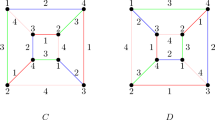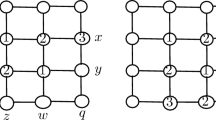Abstract
A graph G is said to be equitably k-colorable if the vertex set of G can be divided into k independent sets for which any two sets differ in size at most one. The equitable chromatic number of G, \(\chi _{=}(G)\), is the minimum k for which G is equitably k-colorable. The equitable chromatic threshold of G, \(\chi _{=}^{*}(G)\), is the minimum k for which G is equitably \(k'\)-colorable for all \(k'\ge k\). In this paper, the exact values of \(\chi _{=}^{*}(G\Box H)\) and \(\chi _{=}(G\Box H)\) are obtained when G is the square of a cycle or a path and H is a complete bipartite graph.






Similar content being viewed by others
References
Baker B, Coffman E (1996) Mutual exclusion scheduling. Theore Comput Sci 162(2):225–243
Blum D, Torrey D, Hammack R (2003) Equitable chromatic number of complete multipartite graphs. Mo J Math Sci 15(2):75–81
Bollobás B, Guy RK (1983) Equitable and proportional coloring of trees. J Comb Theory, B 34:177–186
Bondy JA, Murty USR (1976) Graph theory with applications. The Macmillan press LTD, New York
Chang GJ (2009) A note on equitable colorings of forests. Eur J Comb 30:809–812
Chen BL, Lih KW (1994) Equitable coloring of trees. J Comb Theory Ser B 61(1):83–87
Chen BL, Yen CH (2012) Equitale \(\Delta \)-coloring of graphs. Discret Math 312:1512–1517
Chen BL, Lih KW, Wu PL (1994) Equitable coloring and the maximum degree. Eur J Comb 15(5):443–447
Chen BL, Lih KW, Yen CH (2013) Equivalence of two conjectures on equitable coloring of graphs. J Comb Optim 25:501–504
Furmańczyk H (2004) The equitable coloring of graphs In: Kubale M (ed) Graph colorings, 352. Contemporary Mathematics, AMS, Ann Arbor
Kierstead HA, Kostochka AV (2008a) A short proof of the Hajnal-Szemer\(\acute{e}\)di theorem on equitable coloring. Comb Probab Comput 17(2):265–270
Kierstead HA, Kostochka AV (2008b) An Ore-type theorem on equitable coloring. J Comb Theory Ser B 98:226–234
Kitagawa F, Ikeda H (1988) An existential problem of a weight-controlled subset and its application to schedule timetable construction. Discret Math 72(1–3):195–211
Kostochka AV (2002) Equitable colorings of outerplanar graphs. Discret Math 258(1–3):373–377
Lam PCB, Shiu WC, Tong CS, Zhang CF (2001) On the equitable chromatic number of complete \(n\)-partite graphs. Discret Appl Math 113(2–3):307–310
Lih KW (2013) Equitable coloring of graphs. In: Pardalos PM, Du D-Z, Graham R (eds) Handbook of combinatorial optimization, 2nd edn. Springer, New York, pp 1199–1248
Lih KW, Wu PL (1996) On equitable coloring of bipartite graphs. Discrete Math 151(1–3):155–160
Lin WH, Chang GJ (2012) Equitable colorings of Cartesian products of graphs. Discret Appl Math 160:239–247
Meyer W (1973) Equitable colorings. Am Math Mon 80:920–922
Sabidussi G (1957) Graphs with given group and given graph-theoretical properties. Can J Math 9:515–525
Tong CL, Lin XH, Yang YS, Li ZH (2009) Equitable total coloring of \(C_{m}\Box C_{n}\). Discret Appl Math 157:596–601
Yan Z, Lin WH, Wang W (2014) The equitable chromatic threshold of the Cartesian product of bipartite graphs is at most 4. Taiwan J Math 18:773–780
Yan Z, Wang W (2014) Equitable coloring of Kronecker products of complete multipartite graphs and complete graphs. Discret Appl Math 162:328–333
Zuo L, He S, Xue B (2015) The linear \((n-1)\)-arboricity of Cartesian product graphs. Appl Anal Discret Math 9:13–28
Acknowledgments
We thank the anonymous referee’s helpful suggestions for improving this paper substantial. This work is supported by NSFC for youth with code 61103073.
Author information
Authors and Affiliations
Corresponding author
Rights and permissions
About this article
Cite this article
Ma, S., Zuo, L. Equitable colorings of Cartesian products of square of cycles and paths with complete bipartite graphs. J Comb Optim 32, 725–740 (2016). https://doi.org/10.1007/s10878-015-9895-5
Published:
Issue Date:
DOI: https://doi.org/10.1007/s10878-015-9895-5




